|
Cross Lane Picture House / Plaza Cinema Cross Lane, Great Horton, Bradford.
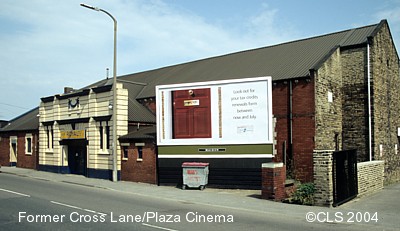
Location The Building Whilst the Ebenezer Place elevation of the rear of the hall suggests three storeys, it was only a single-deck hall with basement at rear and projection room at the top. The auditorium ran lengthways, west to east, on Cross Lane with the entrance at the south side of the hall. Proprietors Interior The proscenium opening of 19 feet with a raked stage 20 feet deep accessed at each side by six narrow and steep wooden steps via the cinema exit passage each side of stage. The proscenium was framed by plaster columns and a decorative top with ornate plaster centre piece. The stage had two dressing rooms immediately above the hall exit doors and each accessed from the stage by another steep and narrow wooden angled staircase. Each dressing room had a few coat hooks and a single corner wash-basin with only cold running water. Although no flytower, there was a good height above the proscenium opening up to the eaves of the pitched roof. The stage overhung the rear external passageway from the exit doors leading up a slope to street level. A woven asbestos fire-safety roller curtain was fitted in vertical iron tracks with a hand-chain mechanism at stage right and weighted at stage left. The curtained exit doors at each side the proscenium opening continued the slope of the side aisles to the panic-bolt double doors into the alleyway under the stage. The hall had generator secondary lighting with wall cones down each side of the auditorium together with gas-mantle wall fittings. Projection Room In the large areas either side of the central projection cabin were large windows with curved tops looking out into the hall from where spotlights and slide projector could be operated. At some unknown later date the large windows were blocked up leaving only a set of portholes for the slide projector. A generator in the cellar provided DC power for the arcs until a full switchover to town mains supply was made. The Opening "The Scales of Justice" - 1914 USA B/w Silent.Newsreels from the war front were to feature regularly. Kine-Variety Commencing Monday 1st October 1923 musical comedy starFather O'Flynn was based on Alfred Perceval Graves' ballad. The film shot in Killarney was a unique production in that is was a synchronetic singing picture with star name performers on stage to accompany the screening. Marie Santoi (real name Mary Fuller) was later seen appearing at the Bradford Alhambra Theatre when she died suddenly in Bradford in 1924 aged 44. In the mid-1920s Arnold Gee was the manager when it was twice-nightly shows and two programme changes per week. In January 1928 there was . . . On StageWhilst the following week it was . . . Brierley and Proud in a novel vocal scenaMeanwhile talkies arrived around 1930 with the installation of the Western Electric sound system. Full Stage Shows "Rose Marie"The are stories about crossing over from one side of the stage to the other to reach dressing rooms by using the covered passage outside as no internal crossover was possible when the full stage was in use - rather cold, wet and windy in early March. Re-opens as Plaza "Re-opening on Monday 10th April 1933 under entirely new management and known as the Plaza Cinema, Cross Lane, with the latest Western Electric super talking apparatus and the finest Western Sound Screen as used in all the leading London cinemas."This sound system was to replace the earlier one and the opening film was . . . The Great Musical ComedyPrices were now 5d to 1/-d for the twice nightly performances. Further advertising boasted . . . "The finest talking pictures in the district at the Plaza".A non-sync turntable installed in the area to the left of the projection box for interval music. By 1935 it had changed to running continuous performance from 6.30pm to 10.45pm. The Richardson family were still involved at the time along with the Oriental in Oak Lane. Nearest competition for the Plaza was the Grange cinema further down Great Horton Road. Throughout the Second World War (1939-1945) and into the 1950s it was continuous programme on weekday evenings with three separate shows on a Saturday - matinée plus two evening performances. By 1950 the price had risen to 6d to 1/9d. Star Takeover A total refurbishment with redecoration, new seating and carpeting plus some important structural changes. A new plain rectangular wooden box-like proscenium was built out in front of the original with a wider opening to accommodate the widescreen and one set of house tabs. The original stage remained unused. This arrangement left unsightly rectangular vertical recesses at either side above the exit doors. It was in a later make-over (date unknown) that the recesses were panelled in and the doors brought forward. Mono sound only as stereo was never installed. Hector J. Hill recalls this conversion anecdote . . . "I remember the CinemaScope proscenium being erected in front (of original stage/screen). The cinema did not close during the work. Films were watched on the old screen through the framework being erected. The new (wide) proscenium had odd footlights - half must have been the originals supplemented by another trough of lights; one being slightly higher and visible.When completed, the manager, Leslie Cooper, displayed two pairs of photos showing before and after conversion with, in each case, the tabs (curtains) both open and closed. Access to the projection room, originally internal from the rear stalls, was removed and its direction reversed with a steep iron staircase accessed now from a new external single door in Ebenezer Place. 'South Pacific' Attraction "South Pacific" - 1958 USA Technicolor 150minsDespite the publicity and the high prices (for a suburban cinema) it was very popular albeit only the 35mm CinemaScope version with optical mono sound. [Many would have already seen the Todd-AO 70mm stereo giant widescreen roadshow version over two years earlier at the specially adapted Majestic cinema in Leeds where it ran for 41 weeks.] The booking form says "Circle Seats" - as there was no Circle, it is assumed this referred to the stepped rows of seats affording a better view at the rear of the hall. A two-week run at these prices was previously unheard of at a small suburban cinema like the Plaza. Closure "The Premature Burial" - 1962 USA Eastmancolor 'Scope 81mins. Bingo In a short closure in 1980 the hall was modified with a flat suspended ceiling and fluorescent lights. Only the front half of the stage was used with a board partition erected behind the bingo equipment and numbers board and false splay walls added to tidy up the sides of the bingo stage. The previously stepped seating at the rear of the hall was removed and the floor levelled to be accessed by five steps with handrails The former dressing rooms and rear half of the stage were just left unused. Remnants of black fabric screen masking and the large louvred sound board for a pair of 12 inch cone speakers were still there until removed in 2009. In the auditorium, the bingo tables and bench seats were arranged on the original raked floor and a refreshment bar added. All projection equipment had been removed earlier. The premises were later known as the Royal Bingo Club run by Stuart Nuttall's Kingsway Clubs in conjunction with a similar bingo operation in the former Oxford cinema at Undercliffe. Bingo ceased in mid 2007. 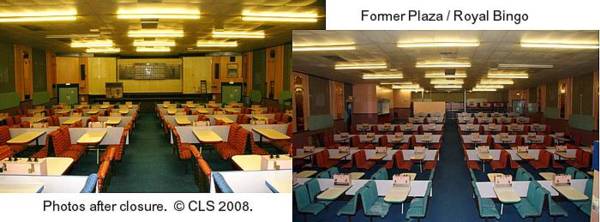 What Next? In 2009 the bingo furniture and refreshment fitments had been removed together with the careful removal of the suspended false ceiling to reveal the original barrel-vaulted ceiling in its 1950s Star painted colours. The 1954 wide proscenium and later bingo stage and its equipment were carefully dismantled revealing the original proscenium opening and its decorative plaster surround. The original fireproof safety roller curtain was revealed and could still be raised and lowered via its handchain. Making good the plasterwork and a simple but tasteful redecoration has successfully restored the hall to its former commodious 1914 size. 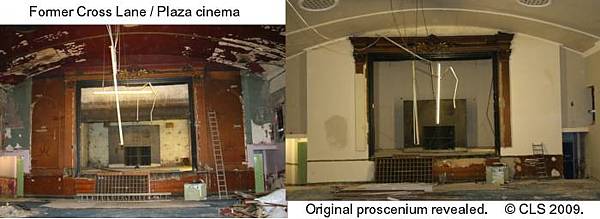 It is expected the hall will eventually be leased out for multi-purpose use with any further internal modifications designed to be reversible. It will be the only remaining 1914 cinema hall in Bradford restored to its original style and still retaining its original stage and soon to reach its centenary milestone. May not be copied or reproduced without permission.
|
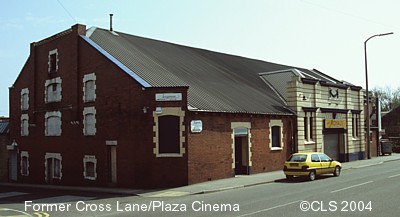 A mixture of red brick and stone with a slate pitched roof and white faience frontage of the main entrance and faience decoration around other doors and windows.
A mixture of red brick and stone with a slate pitched roof and white faience frontage of the main entrance and faience decoration around other doors and windows. The projection room at first (and top) floor level was originally accessed by steep steps from the side of the rear stalls. The whole projection area, spanning the full width of the building, was very spacious by comparison with the small 'boxes' in most cinemas of that period. The height extended right into the eaves of the pitched roof and with outside windows was light and airy. The actual projection room was in a self-contained fireproof room with a flat roof and housed two projectors only. On the extreme left nearest the outside wall was another smaller fireproof cabin to serve as rewind and storage room.
The projection room at first (and top) floor level was originally accessed by steep steps from the side of the rear stalls. The whole projection area, spanning the full width of the building, was very spacious by comparison with the small 'boxes' in most cinemas of that period. The height extended right into the eaves of the pitched roof and with outside windows was light and airy. The actual projection room was in a self-contained fireproof room with a flat roof and housed two projectors only. On the extreme left nearest the outside wall was another smaller fireproof cabin to serve as rewind and storage room.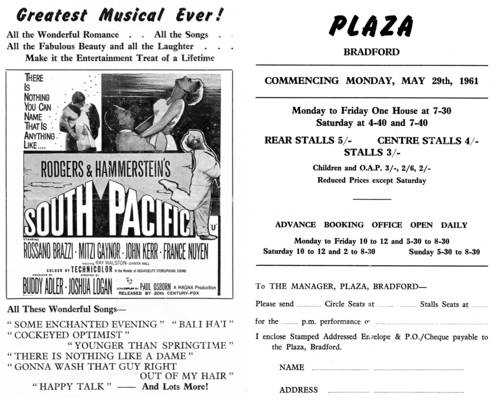 Commencing Monday 29th May 1961 for two weeks was the much heralded arrival of the blockbuster . . .
Commencing Monday 29th May 1961 for two weeks was the much heralded arrival of the blockbuster . . .